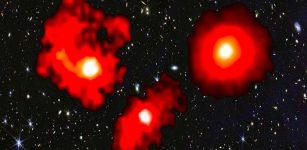Galactic Explosion: New Insight Into The Cosmos With JWST
Eddie Gonzales Jr. – MessageToEagle.com – Using data from the James Webb Space Telescope’s first year of interstellar observation, an international team of researchers could serendipitously view an exploding supernova in a faraway spiral galaxy.
Image credit: qimono – piuxabay
The study, published recently in The Astrophysical Journal Letters, provides new infrared measurements of one of the brightest galaxies in our cosmic neighborhood, NGC 1566, also known as the Spanish Dancer. Located about 40 million light-years away from Earth, the galaxy’s extremely active center has led it to become especially popular with scientists aiming to learn more about how star-forming nebulae form and evolve.
In this case, scientists were able to survey a Type 1a supernova — the explosion of a carbon-oxygen white dwarf star, which Michael Tucker, a fellow at the Center for Cosmology and AstroParticle Physics at The Ohio State University and a co-author of the study, said researchers caught by mere chance while studying NGC 1566.
“White dwarf explosions are important to the field of cosmology, as astronomers often use them as indicators of distance,” said Tucker. “They also produce a huge chunk of the iron group elements in the universe, such as iron, cobalt and nickel.”
The research was made possible thanks to the PHANGS-JWST Survey, which, due to its vast inventory of star cluster measurements, was used to create a reference dataset to study in nearby galaxies. By analyzing images taken of the supernova’s core, Tucker and co-author Ness Mayker Chen, a graduate student in astronomy at Ohio State who led the study, aimed to investigate how certain chemical elements are emitted into the surrounding cosmos after an explosion.
For instance, light elements like hydrogen and helium were formed during the big bang, but heavier elements can be created only through the thermonuclear reactions that happen inside supernovas. Understanding how these stellar reactions affect the distribution of iron elements around the cosmos could give researchers deeper insight into the chemical formation of the universe said Tucker.
“As a supernova explodes, it expands, and as it does so, we can essentially see different layers of the ejecta, which allows us to probe the nebula’s core,” he said. Powered by a process called radioactive decay — wherein an unstable atom releases energy to become more stable — supernovas emit radioactive high-energy photons like uranium-238. In this instance, the study specifically focused on how the isotope cobalt-56 decays into iron-56.
Using data from JWST’s near-infrared and mid-infrared camera instruments to investigate the evolution of these emissions, researchers found that more than 200 days after the initial event, supernova ejecta was still visible at infrared wavelengths that would have been impossible to image from the ground.
“This is one of those studies where if our results weren’t what we expected, it would have been really concerning,” he said in a press release. “We’ve always made the assumption that energy doesn’t escape the ejecta, but until JWST, it was only a theory.”
For many years, it was unclear whether fast-moving particles produced when cobalt-56 decays into iron-56 seeped into the surrounding environment, or were held back by the magnetic fields supernovas create.
Yet by providing new insight into the cooling properties of supernova ejecta, the study confirms that in most circumstances, ejecta doesn’t escape the confines of the explosion. This reaffirms many of the assumptions scientists have made in the past about how these complex entities work, Tucker said.
“This study validates almost 20 years’ worth of science,” he said. “It doesn’t answer every question, but it does a good job of at least showing that our assumptions haven’t been catastrophically wrong.”
Future JWST observations will continue to help scientists develop their theories about star formation and evolution, but Tucker said that further access to other types of imaging filters could help test them as well, creating more opportunities to understand wonders far beyond the edges of our own galaxy.
“The power of JWST is really unparalleled,” said Tucker. “It’s really promising that we’re accomplishing this kind of science and with JWST, there’s a good chance we’ll not only be able to do the same for different kinds of supernovas, but do it even better.”
Written by Eddie Gonzales Jr. – MessageToEagle.com Staff











